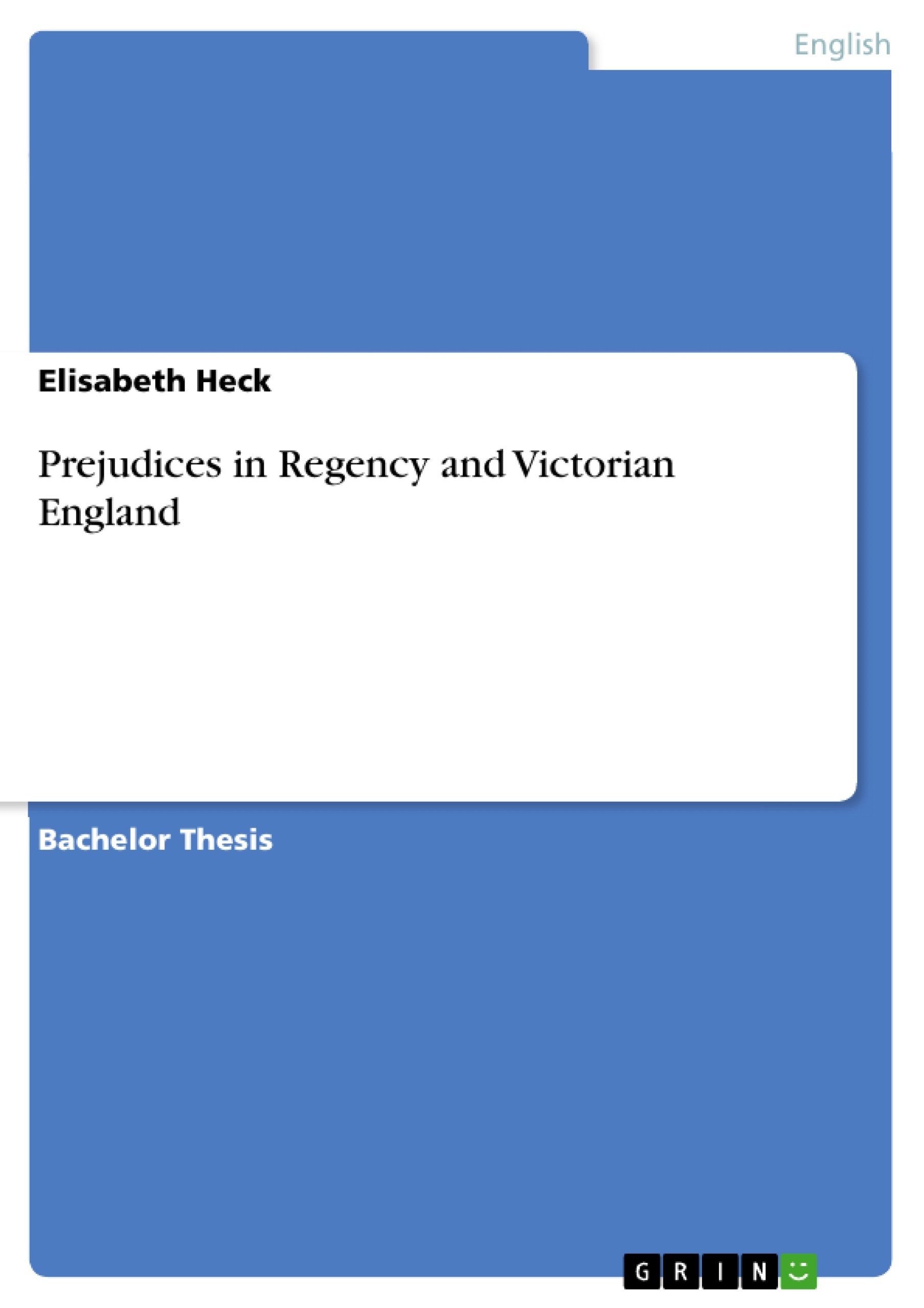This work analyses prejudices in Elizabeth Gaskell’s "North and South" and Jane Austen’s "Pride and Prejudice". Both novels employ a wide range of prejudices which I will compare in categories such as gender, space and class. The thesis basically investigates the constitution of prejudices in the two novels. Moreover, it explores their causes and how the characters eventually overcome them. My aim is to draw a concise and structured overview of the prejudices in "North and South" and "Pride and Prejudice" as well as to compare the characters’ ways of dealing with them.
As a means to a better understanding of my argumentation I will begin with a brief presentation of Regency and Victorian society focusing on their conventions and value
systems. In this context I want to inform about the strictly organised class system, the role of women, as well as regional ideological differences between the North and South of England in both eras which resembled each other to a great extent due to their historical proximity. Beginning then with the practical part of the thesis, I first focus on NS and then on PP; in both cases the interpretation of prejudices is performed based on three categories: class, gender and space. Corresponding to each nove individually, I explore these subgroups on account of their relevance within the book. That is, analysing NS I first refer to the spatial dimension, simply because, in my view, the contrast drawn between North and South England is the starting point for all other types of prejudices in this novel. The same principle applies to PP, where all prejudices emanate from the class hierchary presented by Austen; hence I start discussing the social dimension. To conclude my thesis there will be a thorough comparison of both novels with regard to the presented prejudices.
Inhaltsverzeichnis (Table of Contents)
- Introduction: Prejudices in Regency and Victorian Society
- Prejudices in North and South
- Space: Industrial North and Traditional South
- Class: Southern Genteel Society and Northern Industrial Society
- Gender: Margaret Hale and John Thornton
- Prejudices in Pride and Prejudice
- Class: The Clashing of Classes
- Gender: Elizabeth as Challenger of Gender Conventions
- Space: Aversion Against the North and Country Life
- Overcoming Prejudices
- Conclusion: Margaret and Elizabeth as Mediators
Zielsetzung und Themenschwerpunkte (Objectives and Key Themes)
This thesis analyzes prejudices in Elizabeth Gaskell’s *North and South* and Jane Austen’s *Pride and Prejudice*. The work compares the prejudices within the novels in terms of class, gender, and space. The main objectives are to:- Investigate the constitution of prejudices in both novels
- Explore the causes and eventual overcoming of these prejudices by the characters
- Provide a structured overview of prejudices in *North and South* and *Pride and Prejudice*
- Compare the characters' ways of dealing with prejudices in the two novels
Zusammenfassung der Kapitel (Chapter Summaries)
The introduction begins with a definition of prejudice and explores its use as a term in this thesis. The chapter then outlines the research methodology and objectives, focusing on the comparison of *North and South* and *Pride and Prejudice*. It concludes with a brief overview of Regency and Victorian societies, their class systems, gender roles, and regional differences, setting the stage for the analysis of prejudices in the subsequent chapters.
Chapter 2 analyzes prejudices in *North and South*, exploring the contrasting realities of the industrial North and the traditional South. The chapter examines how class differences, particularly between the southern gentry and the northern industrial society, are portrayed and how these differences create prejudices. The chapter then analyzes the portrayal of gender roles and their influence on prejudice, focusing on the characters of Margaret Hale and John Thornton.
Chapter 3 shifts to *Pride and Prejudice*, delving into the clash of classes, particularly the interactions between the Bennet family and Mr. Darcy. The chapter then examines the challenges to gender conventions presented by Elizabeth Bennet, exploring how her independence and intellect challenge societal expectations. Finally, the chapter analyzes the prejudice against the north and the preference for country life in the novel, revealing the spatial dimensions of prejudice.
Chapter 4 delves into the process of overcoming prejudice in both novels, exploring how characters confront and challenge their preconceived notions. The chapter examines the mechanisms by which characters learn to understand and appreciate perspectives different from their own, highlighting the importance of empathy and open-mindedness.
Schlüsselwörter (Keywords)
This thesis analyzes the theme of prejudice in 19th-century English literature, particularly focusing on the novels *North and South* by Elizabeth Gaskell and *Pride and Prejudice* by Jane Austen. Key themes include class, gender, and space as they relate to the formation and overcoming of prejudices. The thesis examines the social and cultural context of the time, highlighting the rigid class structures, gender roles, and regional differences that contributed to the development of prejudices. The analysis centers on the characters' experiences with prejudice, their responses to it, and ultimately, their efforts to overcome these deeply ingrained societal biases.- Quote paper
- Elisabeth Heck (Author), 2012, Prejudices in Regency and Victorian England, Munich, GRIN Verlag, https://www.grin.com/document/284036



